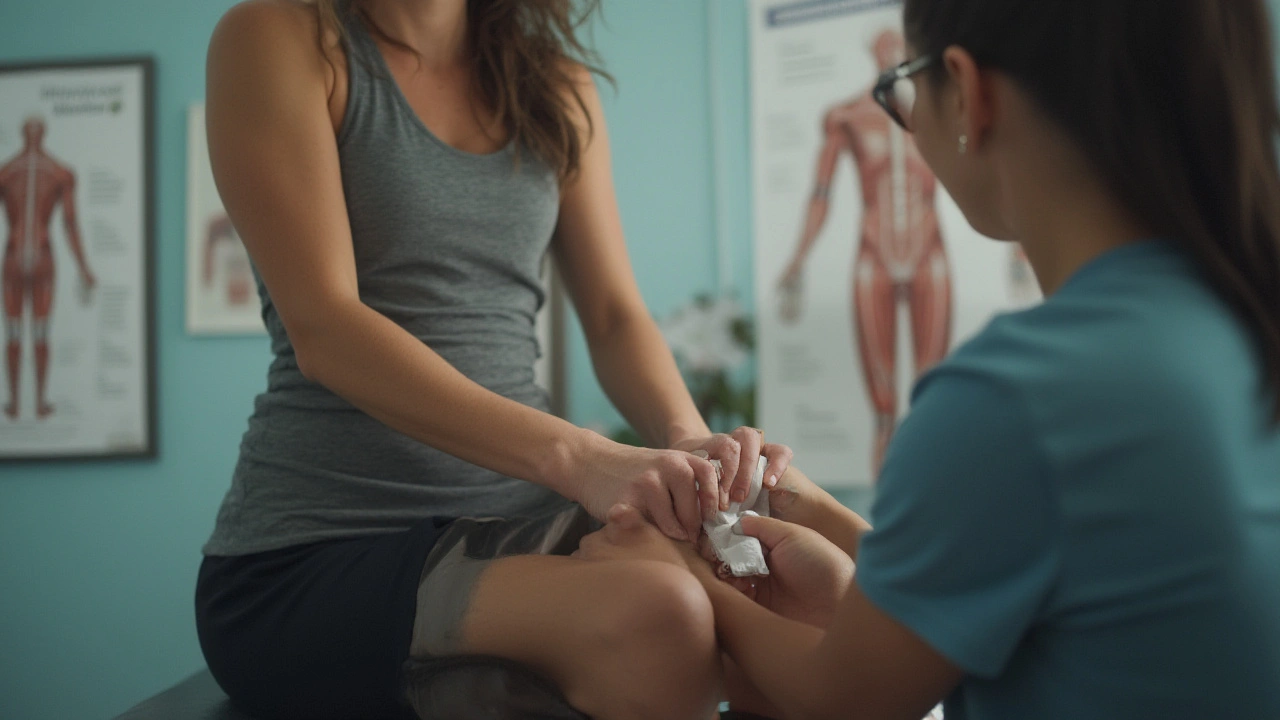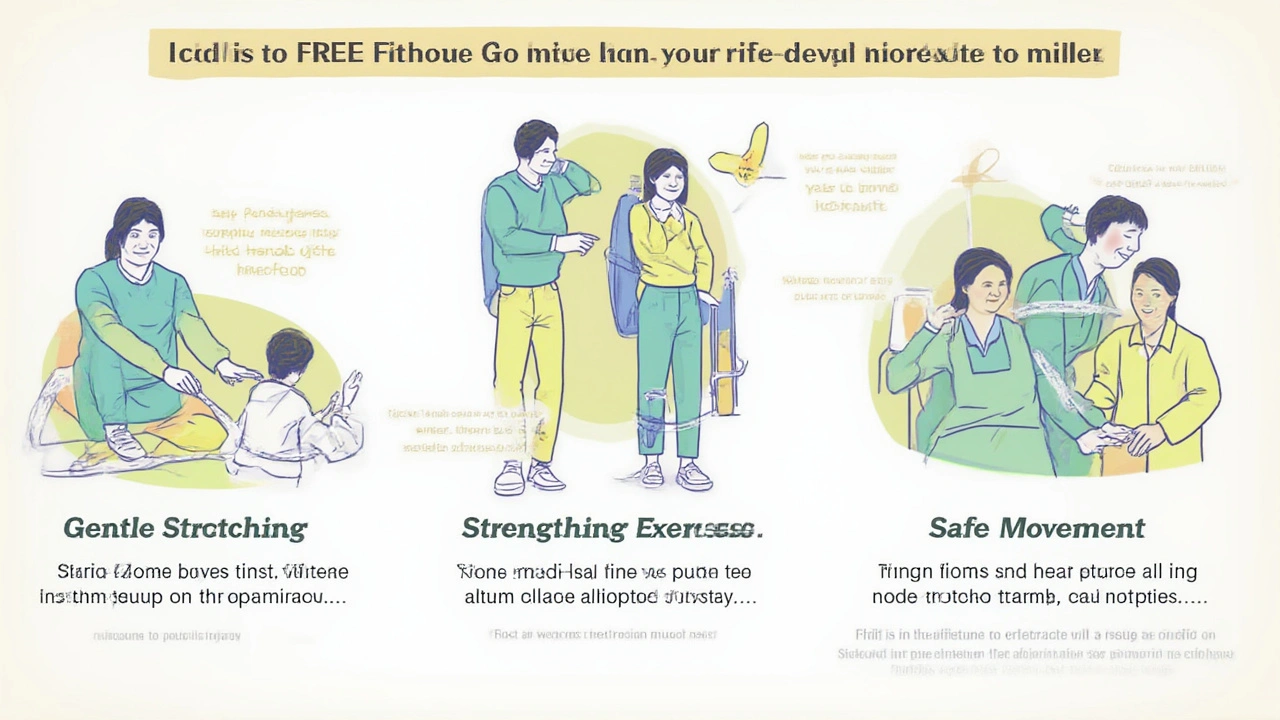If you’ve ever pulled a hamstring mid-jog or wrenched your back hauling a suitcase up the stairs, you know how it feels—the pain, swelling, and frustration all at once. What happens between that initial shock and getting back on your feet matters more than most people realize. Physical therapy isn’t just for pro athletes or folks rehabbing surgeries. It’s a lifeline for anyone battling the pain and limits of acute skeletal muscle injuries, which make up a huge chunk of ER visits and dropped-out-of-gym plans.
How Physical Therapy Works for Acute Skeletal Muscle Conditions
So, what’s going on under the skin when you tear, strain, or bruise a skeletal muscle? Let’s skip the confusing anatomy talk: skeletal muscle is what lets your arms, legs, and everything in between move. When you overdo it—or just have bad luck—those muscle fibers can stretch or snap. Now, your main problem is pain, loss of strength, swelling, sometimes bruising. That’s where the magic of physical therapy steps in.
Picture this. You limp into a clinic with a fresh calf strain. You're greeted by someone who listens, checks your movement, and doesn’t just toss an ice pack your way. A physical therapist zeroes in on what your muscle needs—rest, yes, but also gentle activity at the right moment. They know exactly when to nudge you out of the hurt-but-afraid zone. According to a 2023 report from the American Physical Therapy Association, early physical therapy intervention can cut healing times by up to 35% for common muscle strains compared to folks who just wait it out at home.
Therapists start with one goal: control pain and swelling. This isn’t just about tossing a cold pack at you. They might use things like manual therapy (think hands-on massage techniques), light stretching, or targeted taping. If you twist your ankle, for example, you’ll get specific bandaging and guided movement, not just a generic brace. It's customized care, based on the severity, location, and your personal activity goals. A recent study from the Journal of Orthopaedic & Sports Physical Therapy showed that customized exercise plans led to faster return to normal function than standard, one-size-fits-all exercise sheets.
Therapists are also movement detectives. They’ll watch you walk, squat, or balance while figuring out what hurts and why. Maybe you’re compensating with other muscles without realizing it. This detective work helps them prevent you from developing bad habits during the healing process, which can be just as painful down the line.
See, rest alone isn’t enough. Prolonged inactivity can actually slow healing and weaken muscles further. So therapists guide you through active recovery, focusing on regaining strength, flexibility, and coordination. They use kinetic tape, resistance bands, foam rollers, or even underwater treadmills (yes, these exist in fancy clinics). The approach matches your injury and your goals—whether that means lifting your toddler or training for a 10K.
Physical therapy often involves education, too. You’ll learn about body mechanics: how lifting your groceries with bent knees helps, or why good posture matters, even when texting. Therapists dispel myths—like the old "no pain, no gain" mantra—and teach you what real pain means (not all aches are bad, but some are warnings!). As Dr. Karen Litzy, PT, DPT, put it:
"Physical therapy doesn’t just heal tissues—it empowers people with knowledge so that the next injury isn’t just healed, but prevented."
Here’s something most people miss: physical therapists work across disciplines, collaborating with orthopedic doctors, pain specialists, and even nutritionists. For severe tears or after-surgery cases, they offer post-op protocols suited to the latest evidence, not last decade’s advice. That’s especially important because muscles heal differently as we age, or if there are other health issues in the mix.
Check out these real numbers on muscle conditions:
| Condition | Average Recovery Time (without PT) | Average Recovery Time (with Early PT) |
|---|---|---|
| Hamstring Strain (Mild) | 3-6 weeks | 2-4 weeks |
| Calf Muscle Tear (Moderate) | 6-10 weeks | 4-7 weeks |
| Lower Back Muscle Injury | 4-8 weeks | 2-5 weeks |
The bottom line is this: movement (at the right time, and in the right way) helps muscle fibers realign, scar less, and regain strength. Don’t just park yourself on the couch with iced peas and wish for the best.

Different Physical Therapy Techniques for Acute Muscle Issues
Alright, so you know physical therapy makes sense for muscle injuries. But what actually happens in those sessions? Gone are the days of “tough it out” or endless rest. Therapists have a full toolbox to get you moving better, faster, and safer.
The first tool: manual therapy. This includes everything from basic massage to advanced soft tissue mobilization. Think of it as hands-on science. These techniques don’t just feel good—they boost blood flow, decrease swelling, and break down knots in muscle fibers that can restrict movement or create pain. Sometimes, therapists perform joint mobilization, gently moving the bones near an injured muscle to restore motion. A 2022 survey among physical therapists showed that 82% used manual therapy in the first week after an acute muscle injury, especially in high-motion areas like shoulders and thighs.
Next up: therapeutic exercises. These aren’t your usual squats or stretches from YouTube. They’re laser-focused, starting very basic (like ankle pumps or super-light isometrics) and building up as you heal. For example, after a quad strain, your therapist may guide you through a progression from simple quad squeezes, to partial squats, to dynamic lunges as pain allows. Timing matters: pushing too soon means risk of re-injury, while waiting too long causes stiffness and scar tissue buildup.
Some clinics use modalities—fancy-sounding tech that actually works. These include ultrasound (which can help reduce inflammation by sending sound waves deep into the tissue), electrical stimulation (to wake up weak muscles), and laser therapy. They're not miracle cures, but for certain injuries, especially deep ones or stubborn swelling, these add-ons can shave days or weeks off recovery time.
Need more stability? Therapists often teach taping and bracing techniques. Kinesiology tape—the colorful stuff you see on pro athletes—all isn’t just for looks. When applied correctly, it supports injured muscles and controls swelling, while letting you stay active. If you’ve got a muscle strain in a hard-to-tape area, braces or compression sleeves offer similar protection and confidence.
Let’s talk about education for a second. A huge chunk of muscle injury recoveries stall because of what’s going on in someone’s head—fear of pain, or panic after a muscle twinge. Therapists use practical education and reassurance, setting clear milestones and helping you understand normal healing pain versus signals that you’re pushing too hard. This mental coaching is genuinely part of the treatment—just as vital as hands-on care.
Sometimes, the issue isn’t just the sore muscle, but what’s causing the problem underneath. Maybe your gait is off, your shoes are garbage, or there’s weakness on one side. Movement screening—sometimes using cool video apps—lets therapists see your mechanics in slow-mo. They’ll point out things you’d never notice on your own, then tweak your routines to actually fix the root cause and avoid a round two.
Here’s a practical list of common physical therapy techniques used in acute muscle injuries:
- Manual therapy for pain/swelling
- Progressive therapeutic exercises (tailored to the muscle group)
- Ultrasound or electrical stimulation (for deeper injuries)
- Taping and bracing (for support)
- Education/coaching (so you avoid common setbacks)
- Movement analysis to prevent re-injury
A 2024 review in Physical Therapy in Sport found that patients who received this full-spectrum care—therapy mixed with tech, coaching, and personalized programs—were 42% less likely to have a repeat muscle injury within a year, compared to those only using home rest or self-guided rehab apps.
Don’t forget, PT clinics can be pretty creative. Maybe you’ll do agility drills, work balance on a Bosu ball, or even hop in a hydrotherapy pool if you’re coming back from a bad calf tear. This variety keeps the healing process engaging and tackles every angle, from rebuilding muscle to regaining confidence in your everyday moves.

Tips to Boost Your Muscle Recovery During Physical Therapy
Getting the most out of physical therapy comes down to more than just showing up. You can turbocharge your healing, avoid common roadblocks, and make your life a whole lot easier with a few smart habits and strategies.
First, communicate openly—always tell your therapist what feels good and what doesn’t, even if it feels minor. Tiny tweaks in your rehab plan can make a big difference, especially if you’re balancing pain and progress. If you notice new swelling, bruising, or pain that just won’t quit, speak up. This isn’t the time for a stiff upper lip.
Consistency matters. Your therapist will give you a home exercise plan, and yes, it’s tempting to skip a day (or three). But data from a 2023 analysis of over 5,000 muscle injury recoveries showed people who did at least 80% of their PT homework had 28% shorter recoveries than those who were less consistent. Make it a routine—pair stretches with brushing your teeth, or squeeze in resistance moves while watching TV.
Stay hydrated, eat enough protein, and sleep well. Your muscles need fuel and rest to repair. Think of protein like the bricks in a house—without enough, your body takes longer to rebuild tissue. Most therapists suggest about 1.2 to 2 grams of protein per kilogram of body weight for adults in recovery. That’s a couple of chicken breasts, a scoop of Greek yogurt, or a protein shake (whatever fits your style and diet).
Don’t be afraid to ask questions—about pain, timelines, or exercises. The best therapists want you to understand every step. If you’re doing something at home and aren’t sure about your form, ask for a video or demo. Avoid guessing!
Patience is key. Even minor muscle injuries can nag for weeks, and pushing too hard (or too soon) might set you back. Look for steady progress: is your pain scoring lower by the week? Are you moving with less stiffness each session? Celebrate small wins—clear the stairs without limping, pick up a bag of groceries, jog pain-free for five minutes.
Compare your healing timeline with others, but remember it’s not a race. Muscles heal at their own pace, and your job, with help from your PT, is to give it the best shot. Track pain and function with a journal or notes app to see your actual gains over time.
Finally, stick to your follow-ups! Modern PT often checks for proper muscle function months after your first symptoms fade—they’re not just milking extra sessions. Small asymmetries or lingering weaknesses can set you up for fresh injuries if ignored. Think of it as tuning a car after a crash—you want the engine running perfect, not "good enough."
Physical therapy doesn’t just patch up a muscle—it helps future proof your body against similar flare-ups. No shortcuts here. Listen to your therapist, move regularly, fuel up, and respect the healing process. Next time you tweak a muscle, you’ll know exactly what to do—and bounce back a lot smarter, maybe even stronger than before.

11 Comments
Aarti RayJuly 17, 2025 AT 07:13
I tried PT after pulling my hamstring last monsoon and it was a game changer honestly
My mom thought rest was enough but nope i was limping for months until i went to a clinic
Therapist gave me simple moves and told me to do em daily even if i felt like crap
Now i can run again without thinking about it
Also they taught me how to lift groceries right lol
Alexander RolsenJuly 19, 2025 AT 00:01
Physical therapy? That's just expensive placebo for people who can't handle pain. In my day, we just rested, took ibuprofen, and got back up. No fancy taping. No ultrasound. No "movement detectives." We didn't need it. America's gotten soft. You want to recover? Stop whining and move. Pain is just weakness leaving the body. And if it doesn't? Then maybe you shouldn't be running in the first place.
Leah DoyleJuly 20, 2025 AT 10:12
OMG YES this is so true!! I tore my quad last year and just tried to tough it out... ended up with a weird limp for 3 months 😭
Then I went to PT and the lady didn't just give me exercises-she actually listened to me and adjusted everything based on how I felt each day
And the education part?? I never knew that poor posture while scrolling could wreck your lower back
Also I cried during one session because she said "you're doing great" and I hadn't heard that in months
PT isn't just treatment-it's emotional support too 🥹
Alexis MendozaJuly 21, 2025 AT 20:38
It's funny how we think rest is healing. But rest without movement is just waiting. Healing is active. It's not about fixing a broken thing-it's about helping the body remember how to be whole again.
Maybe that's why PT works. It doesn't just treat the injury. It reminds the body of its own intelligence.
We forget that our bodies know how to heal. We just need to give them the right conditions. Not just ice and pills. But guidance. Patience. Trust.
And maybe that's the real therapy.
Michelle N AllenJuly 21, 2025 AT 21:18
I read all of this and honestly I'm just tired. I hurt my back lifting a suitcase last winter and I just sat on the couch for six weeks. I didn't go to PT because I didn't have insurance and also I didn't feel like driving. Now I still have stiffness and I'm not even mad about it. I mean, life happens. You get hurt. You rest. You get better. Or you don't. Either way it's not like I'm going to pay $200 a session to learn how to squat. I'll just keep doing my stretches on YouTube. They're free. And I'm not going to feel guilty about it. My body knows what it's doing. Probably.
Madison MaloneJuly 22, 2025 AT 08:28
This is exactly what I needed to read. I was so scared to move after my calf strain-I thought any movement would make it worse
My PT told me "pain isn't the enemy, fear is" and that changed everything
She made me start with just wiggling my toes and slowly built up
Now I'm walking without a limp and I actually feel stronger than before
If you're scared to start PT, just take the first step. Even if it's tiny. You're not alone.
Graham Moyer-StrattonJuly 24, 2025 AT 05:33
PT works. But only because people are lazy. Stop blaming your injuries on bad luck. Train smarter. Move daily. Don't wait for someone to tell you what to do. Just do it. The rest is noise.
tom charltonJuly 25, 2025 AT 01:53
While the clinical efficacy of early physical therapy intervention is well-documented in peer-reviewed literature, it is imperative to acknowledge the systemic barriers to access that prevent equitable implementation. Many individuals, particularly in underserved communities, face financial, geographic, and cultural impediments to receiving timely care. The data presented here is compelling, yet incomplete without addressing structural inequities in healthcare delivery. We must advocate for policy reform that ensures physical therapy is not a privilege, but a right.
Jacob Hepworth-wainJuly 26, 2025 AT 03:08
I used to think PT was just for athletes but my dad had a bad back after moving and the therapist had him doing tiny balance drills on a pillow
It looked silly but after 3 weeks he could walk without wincing
Turns out it wasn't about strength-it was about retraining his brain to trust his body again
Best part? He still does the drills every morning
Now he's the one telling everyone to try it
Craig HartelJuly 26, 2025 AT 23:28
My cousin in India did PT after a knee injury and she said the therapist taught her how to walk again using just a wall and her own breath
She said it felt more like yoga than medicine
And now she teaches it to other women in her village
Physical therapy isn't just science-it's connection
And sometimes that's what heals the most
Chris KahanicJuly 27, 2025 AT 02:07
Interesting article. The data on recovery timelines is consistent with recent meta-analyses. However, the emphasis on individualized care aligns more with patient-centered models than traditional biomedical paradigms. The integration of movement screening and psychological reassurance suggests a shift toward biopsychosocial frameworks in musculoskeletal rehabilitation. Further research on long-term adherence to home programs would be valuable.